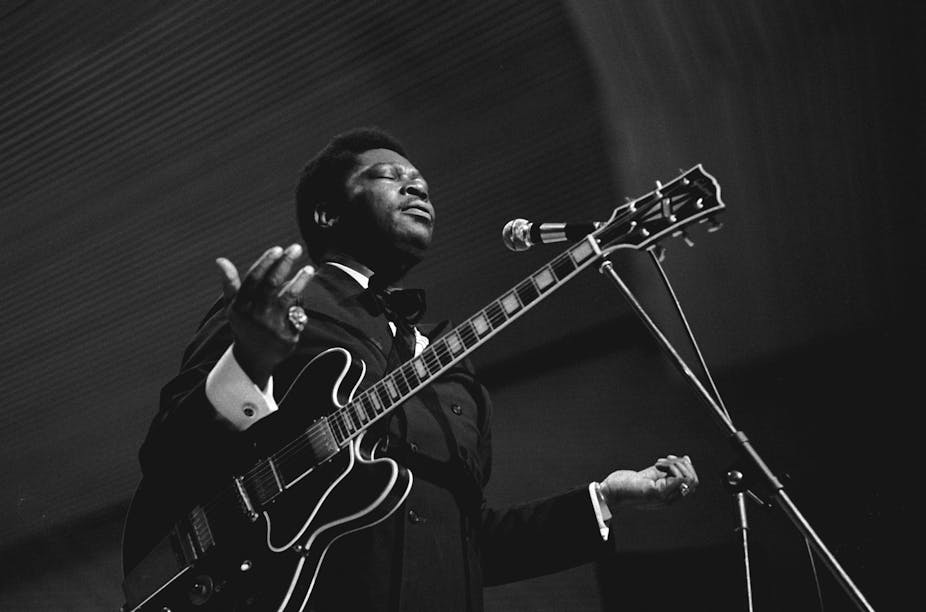BB King is remembered as one of the most important artists in the history of blues, with a long career that spanned seven decades and included classic hits such as Three O’Clock Blues (1951), The Thrill is Gone (1969) and 1989’s When Love Comes to Town (recorded with U2). Widely considered one of the most influential guitarists of the 20th century, he became, in his later years, a celebrated icon of blues authenticity.
Had it not been for his early days in radio, however, things might have turned out differently for a young Riley King.
When Riley King came to Memphis, Tennessee in the late 1940s and gained prominence as a DJ, he put himself at the center of one of the country’s most active blues scenes.
Whether it was access to a large record collection or gigs fueled by his growing celebrity as a DJ, the young bluesman brilliantly exploited each opportunity that came his way.
The right place at the right time
Radio in the years after World War II was changing rapidly. The nationally syndicated networks that had driven radio in previous decades were now devoting their resources to a new technology: television.
As TV increasingly drew a mass, national audience, radio homed in on appealing to local and regional listeners. This shift gave stations the freedom to innovate. One change was an uptick in the airing of rhythm & blues music, sometimes in late-night spots and sometimes – like at WDIA Memphis – all day and night.
The DJs spinning R&B records were often white: John R Richbourg at WLAC in Nashville and Zenas “Daddy” Sears at Atlanta’s WGST. (One of these white DJs, Ohio’s Alan Freed, would become pivotal in the birth of rock and roll.)
In late 1948, a young BB King was an aspiring blues artist then performing under his birth name, Riley King. He made his way from Indianola, Mississippi to Memphis by working on a delivery truck to pay his fare. He’d already visited the River City once as the guest of his cousin, Bukka White.
King, who had worked primarily in the cotton fields of Mississippi while singing with a gospel choir and playing blues on the street, sought out greener pastures in the music business.
So for this second visit, young Riley had a plan: he would get himself on blues singer Sonny Boy Willimson’s King Biscuit Time show on KFFA – a broadcast King loved from his days picking cotton. Williamson put King on the air singing Blues at Sunrise, and got him a performing gig at the 16th Street Grill in West Memphis. To keep this new gig, King had to get the club mentioned on the radio.

After his impromptu performance at KFFA, King ambitiously headed off to WDIA in Memphis, a white-owned station that employed an all-black on-air lineup, which included Nat D Williams, Maurice “Hot Rod” Hulbert and Rufus Thomas. King initially got a regular 10-minute spot promoting an elixir called Pepticon (“good for whatever ails you”), while even writing a jingle (and getting in a plug for his gig).
Soon the young DJ had a more extended slot as host of Sepia Swing Club. He later said that he partly modeled his on-air personality on the nationally known white radio host and performer Arthur Godfrey.
A radio star was born: BB King.
Exposure, influence – and stardom
King’s regular spot on the radio gave the DJ name recognition, and his performing gigs continued to roll in. Soon, he was playing regional shows in addition to the local Memphis ones. Being on the radio also helped King understand audiences: he learned what listeners wanted and how to craft an on-stage personality.
As a regular at WDIA, King had access to the station’s record library. This allowed him to become familiar with a wide range of musical styles within rhythm and blues – something that would not have been possible for almost anyone outside of the industry. Aside from being exposed to new sounds, he got to know the artists and the industry representatives who came through town to promote their records.
King had bombed with his first record release as an artist, Miss Martha King, which he recorded at WDIA and released by Bullet Records. (King would joke that it was “bad enough to drive Bullet into bankruptcy.”)
But when Jules Bihari and his brothers came through town promoting Modern Records at the station, they met King, who had been recommended to them by Ike Turner (King and Ike had done some gigs together). King signed with the Bihari brothers, who released his singles on RPM (a subsidiary of Modern), even recording some of these at Sun Studios with Sam Phillips. (Sun would later be home to Elvis Presley, Carl Perkins, Jerry Lee Lewis, Johnny Cash and Roy Orbison.)
One record BB King often played while deejaying at WDIA was a single by Lowell Fulson, Three O'Clock Blues. According to Fulson, King played the record more than any other DJ in the country. Soon, King decided to take a stab at his own version of Fulson’s song.
King’s version of Three O'Clock Blues went to number one in the national rhythm and blues charts in early 1952. Having a chart-topper meant that BB could hit the road, and he began a life of extensive touring that would continue for decades. Being on the road so much made it impossible for him to continue as a DJ, and his success as an artist effectively ended his career in radio.
But in looking back at the musician’s long and successful career, the impact of radio on BB King’s rise can’t be understated.
It opened a door for the young King, one that he was happy to walk through.

